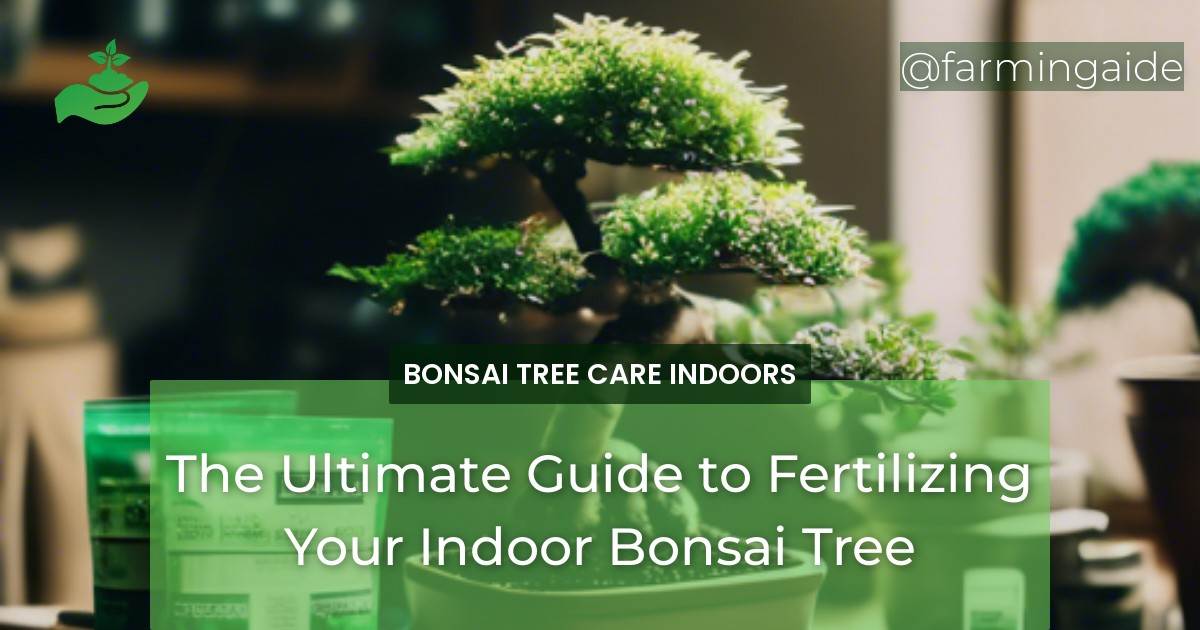As an indoor gardening enthusiast, you’re likely no stranger to the world of bonsai trees. These miniature marvels require careful attention to thrive, and one crucial aspect of their care is fertilization. In this comprehensive guide, we’ll delve into the world of fertilizing indoor bonsai trees, covering the essential nutrients, types of fertilizers, and expert techniques to promote healthy growth and flourishing beauty.
Key Takeaways
- Fertilize your indoor bonsai tree regularly to promote healthy growth and prevent nutrient deficiencies.
- Understand the three primary macronutrients: nitrogen, phosphorus, and potassium.
- Choose a balanced, water-soluble fertilizer specifically formulated for bonsai trees.
- Avoid over-fertilization, as it can harm your tree.
- Monitor your tree’s health and adjust fertilization schedules accordingly.
Understanding Your Indoor Bonsai Tree
Before diving into the world of fertilization, it’s essential to understand the unique needs of your indoor bonsai tree. These trees, unlike their outdoor counterparts, require more attention to thrive in indoor conditions. With limited space and controlled environments, indoor bonsai trees need tailored care to flourish.
There are several types of bonsai trees suited for indoor growth, each with its unique characteristics and requirements. Ficus, Chinese Elm, and Satsuki Azalea are popular choices for indoor bonsai cultivation. Understanding the specific needs of your tree species will help you provide optimal care and fertilization.
Types of Bonsai Trees Suited for Indoors
When selecting an indoor bonsai tree, consider the following popular species:
- Ficus (Ficus spp.): A popular choice for indoor bonsai, Ficus trees are adaptable and relatively low-maintenance.
- Chinese Elm (Ulmus parvifolia): With its small leaves and tolerance for indoor conditions, Chinese Elm is an excellent choice for beginners.
- Satsuki Azalea (Rhododendron satsuki): This evergreen shrub produces vibrant flowers and responds well to indoor conditions.
Nutrient Needs of Indoor Bonsai Trees
Indoor bonsai trees require a balanced diet of macronutrients and micronutrients to thrive. The primary macronutrients are nitrogen (N), phosphorus (P), and potassium (K). These elements play crucial roles in promoting healthy growth, root development, and overall tree health.
Essential Nutrients for Bonsai Trees
A balanced fertilizer provides the necessary nutrients for your indoor bonsai tree’s growth and development. The three primary macronutrients are:
ALSO READ
The Role of Nitrogen, Phosphorus, and Potassium
Nitrogen (N) promotes leaf growth and green color, phosphorus (P) supports root development and flowering, and potassium (K) helps with overall tree health and resistance to disease.
Importance of Micronutrients
Micronutrients, such as iron, zinc, and boron, are also essential for your bonsai tree’s health. While required in smaller quantities, these elements play critical roles in enzyme function, photosynthesis, and overall tree development.
Choosing the Right Fertilizer
Selecting the right fertilizer for your indoor bonsai tree is crucial. With numerous options available, it’s essential to choose a balanced, water-soluble fertilizer specifically formulated for bonsai trees.
ALSO READ
Organic vs. Synthetic Fertilizers
Organic fertilizers, derived from natural sources, release nutrients slowly and promote beneficial microbial activity. Synthetic fertilizers, on the other hand, provide instant nutrients but may harm soil microorganisms.
Balanced Fertilizers for Bonsai Trees
A balanced fertilizer with an N-P-K ratio of 20-20-20 or 10-10-10 is suitable for most indoor bonsai trees. Look for a water-soluble fertilizer specifically formulated for bonsai trees to ensure optimal nutrient delivery.
Fertilizing Techniques and Schedules
Fertilizing your indoor bonsai tree requires a thoughtful approach to avoid over-fertilization and promote healthy growth.
When to Start Fertilizing
Begin fertilizing your indoor bonsai tree once it’s established, typically after the first year of growth. Fertilize during the growing season (spring-fall) and reduce or stop fertilization during the dormant season (winter).
Frequency and Dosage of Fertilizer
Fertilize your indoor bonsai tree every 1-2 weeks during the growing season, using half the recommended dosage. This will help prevent over-fertilization and promote steady growth.
Common Mistakes to Avoid
Avoid these common mistakes to ensure your indoor bonsai tree receives the necessary care:
Over-fertilization and Its Effects
Over-fertilization can cause root burn, nutrient deficiencies, and even tree death. Monitor your tree’s health and adjust fertilization schedules accordingly.
Correcting Nutrient Deficiencies
Identify nutrient deficiencies by observing signs such as yellowing leaves or weak growth. Adjust your fertilization schedule and consider adding supplements to address specific deficiencies.
Monitoring Your Bonsai Tree’s Health
Regularly inspect your indoor bonsai tree for signs of proper nutrition and potential issues:
Signs of Proper Nutrition
A healthy bonsai tree will exhibit:
- Vibrant, green foliage
- Strong, sturdy branches
- New growth and development
Troubleshooting Common Issues
Be prepared to address common issues, such as:
- Yellowing leaves: Check for nutrient deficiencies or over-watering.
- Weakened branches: Adjust fertilization schedules or prune weakened areas.
Conclusion and Final Tips for Bonsai Care
In conclusion, fertilizing your indoor bonsai tree is a crucial aspect of its care. By understanding the essential nutrients, choosing the right fertilizer, and following expert techniques, you’ll be well on your way to growing a thriving, beautiful bonsai tree. Remember to monitor your tree’s health, avoid common mistakes, and adjust your care routine accordingly.
By following these guidelines and tips, you’ll be well-equipped to provide your indoor bonsai tree with the care it needs to flourish. Happy growing!


